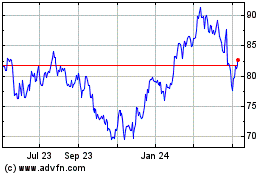Uphill Ride For Canadian Pacific-Norfolk Southern Deal
November 27 2015 - 3:02AM
Dow Jones News
(FROM THE WALL STREET JOURNAL 11/27/15)
By Ronald Barusch
Before it can get on the rails, Canadian Pacific Railway Ltd.'s
proposed acquisition of Norfolk Southern Corp. has some difficult
terrain to traverse.
Norfolk Southern hasn't formally responded to CP's bid, but it
has pledged to evaluate the offer. Yet even while making that
pledge, Norfolk Southern last week called the bid "unsolicited,
low-premium, nonbinding and highly conditional" -- all buzzwords
indicating an aggressive takeover defense is in the offing. Should
CP choose to proceed with a hostile deal, getting regulatory
approval could pose extraordinary challenges.
Unlike most other U.S. deals in which the primary regulatory
issue tends to be the effect on competition, a proposed merger of
CP and Norfolk Southern would be considered by the U.S. Surface
Transportation Board, which is required to determine if the deal is
"consistent with the public interest."
The law requires the board to consider factors in addition to
competition, including the effect on transportation, the interests
of employees and whether other railroads should be included in the
deal. The public interest review by the board can extend over many
months. One competing railroad, Union Pacific Corp., has already
indicated it generally opposes rail-industry mergers. Union Pacific
said "the regulatory hurdles for future consolidation would be
significant." Even CP's proposal letter to Norfolk Southern assumed
the closing would occur on Dec. 31, 2017.
If the Norfolk board opposes the deal, it could delay the
regulatory process and increase the risk approval may not
ultimately be obtained on acceptable terms.
CP Chief Executive Hunter Harrison has indicated he has a
solution: placing one of the railroads in a voting trust. With such
a structure, the business of the railroad in question would be
controlled by an independent trustee. The closing of the deal as
far as the Norfolk Southern shareholders are concerned would come
at a relatively early date. The two railroads would be run
separately until whatever the board ultimately determines is
implemented.
The use of this type of voting trust to allow early closings of
deals has a long history. But CP could face some challenges in
implementing it now.
To implement a voting trust requires formal approval by the
surface board following public comment.
We don't know how long the trust approval process would take
because it doesn't appear that there has been a proceeding relating
to a major transaction since the current rules were put in place
more than a decade ago.
Also, it appears Mr. Harrison is considering putting CP into the
trust and immediately becoming CEO of Norfolk Southern. That
structure would be unusual because generally the target railroad
goes into the trust. Mr. Harrison was involved in another
transaction in which it was tried, but that deal wasn't completed.
It is hard to figure out how, if Mr. Harrison immediately began
running Norfolk Southern and CP went into a trust, the eggs could
be unscrambled if the board didn't approve the merger.
There could be another issue with the interim trust structure.
In its proposal letter, CP calculated the value of the shares of
the combined company. Using that calculation, the shares to be
received by Norfolk Southern holders would constitute about
two-thirds of the value received by them. If CP proposes a
transaction in which one of the companies remains in limbo for a
time, that could make it difficult for Norfolk Southern's board to
value a significant part of the consideration. And that could add
to the difficulty for CP of getting a friendly deal.
Of course even if directors of Norfolk Southern don't warm to
the deal, it is possible a Norfolk Southern shareholder or even CP
could seek to elect new directors at next year's Norfolk Southern
annual meeting.
In an email, a spokesman for CP said the company believes the
deal would bolster competition and it would satisfy any concerns
from regulators.
Given that in heavily regulated industries like railroads,
enthusiastic support of a target is an important element in
facilitating a takeover, CP has its work cut out.
---
Mr. Barusch is a retired mergers and acquisitions lawyer who
writes about deal making for the Journal's MoneyBeat blog at
wsj.com/moneybeat.
Subscribe to WSJ: http://online.wsj.com?mod=djnwires
(END) Dow Jones Newswires
November 27, 2015 02:47 ET (07:47 GMT)
Copyright (c) 2015 Dow Jones & Company, Inc.
Canadian Pacific Kansas ... (NYSE:CP)
Historical Stock Chart
From Mar 2024 to Apr 2024

Canadian Pacific Kansas ... (NYSE:CP)
Historical Stock Chart
From Apr 2023 to Apr 2024
